Crossings and rails are most often equipped with special devices that lie on reinforced concrete or wooden transfer bars, which differ in length from any sleepers, and otherwise they are similar. These are turnouts, existing in order to change the path of a train, moving its course from one railway line to another.

Classification
Places of transfers when crossing or connecting rails can be classified by location and quantity, by type of rails, by design and marks of crosspieces. These can be single turnouts, as well as cross, dull intersections, ramps, turnouts and plexuses, if viewed in terms of quantity and location. Ordinary arrows consist of two rails (frame), two sets of root device, two wits, one set of the translation mechanism itself, switch rods, thrust and support devices, as well as smaller parts.
Railroad switches differ from each other both by frame rails, and wags, and designs of transfer devices, and fastenings of frame rails. There may be a variety of minor differences: the transverse connections between the frame rails and the witches, the design of the thrust device, and special arrow pads can also be different. The turnout device is closely related to the size of the wheelsets and the design of the rolling stock.
The steel axle of the wheelset holds the wheels tightly with guide flanges to prevent the car from coming off the rails. All turnout elements are designed to interact with certain sizes of wheel sets.
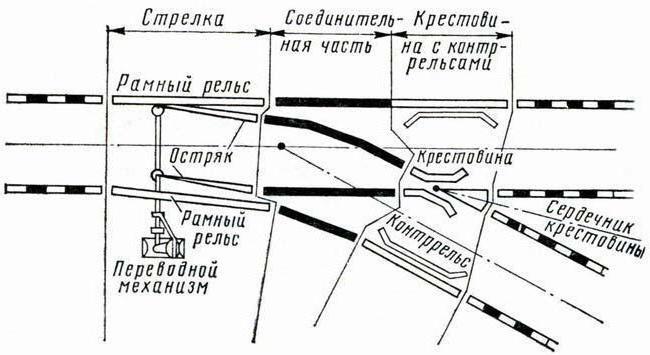
Divisions
The rolling stock passes to another path through a special device that crosses and connects the tracks along their upper structure. The intersection of paths is carried out by dull intersections, and turnouts help to connect them. In this way, connections are created that are called turnouts and streets. Types of turnouts:
- single;
- double;
- cross
Single are divided, in turn, into:
- ordinary;
- symmetrical;
- asymmetrical.
Also, the translation connecting the two paths can be left- and right-handed, and is used if the side path deviates in any direction from the straight line. This is the most common type of translation.
Composition
The main turnouts consist of the turnout itself, a cross with counter rails, the connecting part, which is located between them, and the transverse bars. The arrow is made up of two frame rails, a transfer mechanism and two wits, with the help of which the rolling stock changes direction to the side or direct path.
The witters are connected by transverse links, which lead the desired tightly to the frame rail, while the other simultaneously moves away from the parallel frame rail just by the distance that is necessary for the passage of the wheel flanges. Turnout failures almost always lead to an accident. For example, if the core is broken, the guardrail or counter-rail is damaged, it is strictly forbidden to use the arrow.
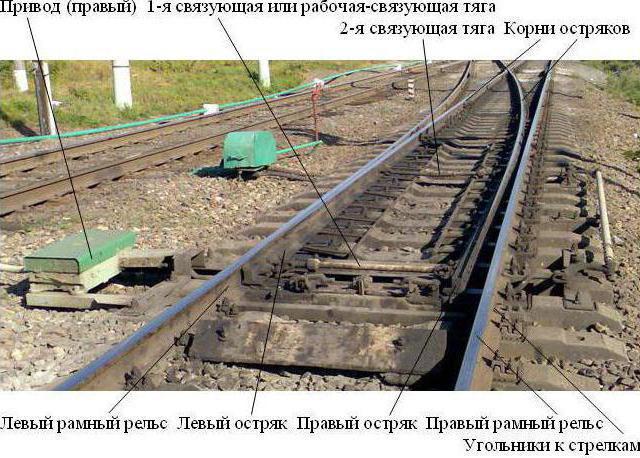
Functions
All types of turnouts translate wits differently, but the principle is always the same. Special switch drives carry out this transition through one link, but if the switch is gentle - with long wits, then through two or more links.
With a locking device, the wits are fixed in a new position, and their tight fit is controlled by them. The thick end of the wit is called the root, and the thin - the tip. The root is fastened and provides all the wits of the wits in a plane, and also connects them with the adjacent rails.
Terminology
The crosspiece consists of two guardrails, the core and the grooves, it is she who is responsible for the intersection of the rail heads with the wheel flange, and the counter rails at the same time guide these ridges into the desired grooves so that the wheel pair smoothly passes the cross.
The cross has even its own mathematical center - at the intersection of the working faces on the core. Its narrowest place is called the throat of the cross, which is located between the guardrails. And the angle between the working faces of the core is the angle of the cross. This is how the main turnout is designed, the scheme of which is presented in the illustration below.
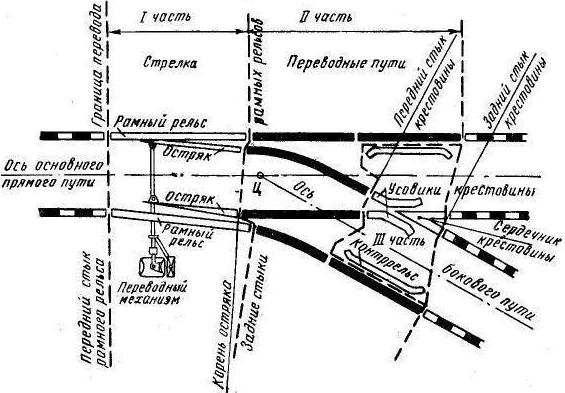
Spider
The most important of the parameters is the mark of the cross. Russian railways widely use the reinforced turnout design - with cast, grade 1.11, a cross and flexible wits. These turnout projects guarantee the advancement of trains on straight sections of the track at a tremendous speed - up to one hundred and sixty kilometers per hour.
If the trains deviate from the main track, the arrows of a gentle mark 1.18 are used, and then the speed is still high - eighty kilometers per hour. Switch failures with such rapid train movement can lead to very serious consequences. “Sapsan” between Moscow and St. Petersburg reaches two hundred kilometers per hour along a direct route, there are arrows everywhere with a 1.11 mark cross. A feature of such a cross is a movable flexible core. In working positions, it fits very tightly to the desired face of the guardrail.
Congresses
This is also a very common path junction device. The congresses vary depending on the location of the tracks:
- abbreviated;
- cross
- ordinary.
The usual exit is two single turnouts and a connecting path that fits between the roots of the crosses. Cross, means a double congress, having four turnouts and one dead intersection between the roots of the crosses. This design is used when the length of the plot does not allow two single exits to be equipped, cramped conditions force the use of a different design turnout. The scheme is attached in the article.
If the transfer from one path to another is not necessary, but the paths intersect, they arrange a cross exit with blind intersections at an acute or right angle. On railways, such exits are widespread at an acute angle, where crosses of grades 2.11 and 2.9 are used. Such intersections contain four crosses with counter rails - two blunt, two sharp. Rectangular intersections always with identical crosses.
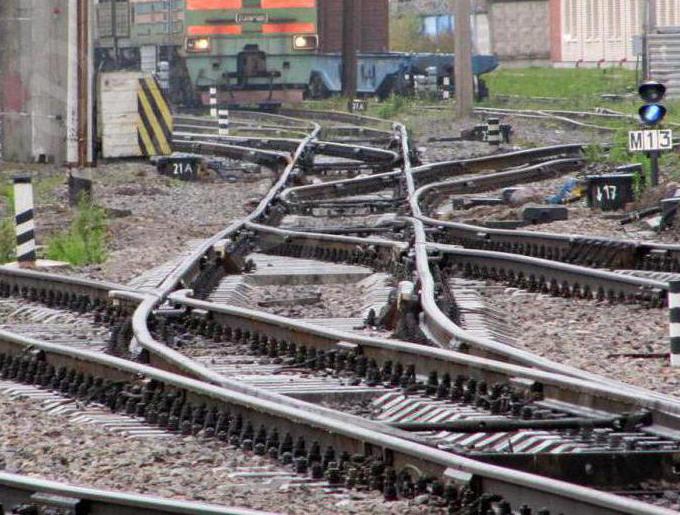
Strelochnaya street
Consistently located turnouts from one path to parallel make this thorny path turnout street. So, rolling stock can be moved to any of these connected tracks. If the group of paths has one purpose, then the arrow streets are combined into parks. They also come in different types, it depends on the location of themselves and the main path, as well as on the angle of inclination.
- The simplest arrow streets, if there are large distances between the axes (more than seven meters) of the tracks, are usually very long. Because of this, a shortened connection is made to adjoin the station tracks. Schemes can be all kinds of, even fundamentally different. Such streets are good in that they are perfectly visible, they are convenient to maintain. There is one drawback - they take up a lot of space, and if the number of paths is large, then the length increases very significantly. They are used for the most part in small departure and reception parks, up to five routes.
- Shortened arrow streets are shorter, but they are inconvenient in maneuvering on paths with reverse curves. Such streets are used in coal depots, at bases, in large cargo yards, at industrial sites.
- The arrow street at a double angle of the crosspiece reduces the length of the arrow zone, is convenient for a shunting flight, and far arrows are clearly visible. It is applied where there are more than five ways. These are the necks of the reception and departure parks, on sortings in the absence of a slide.
- When laying with a constant radius of all curves, a non-concentric fan-shaped turnout street increases the interblocks on the head section of the park, the volume of excavation work when laying such a street is extremely large. In this case, it is possible to increase the radii of the curves, however, it is necessary to carefully monitor the interbands so that all parameters correspond to the tolerance.
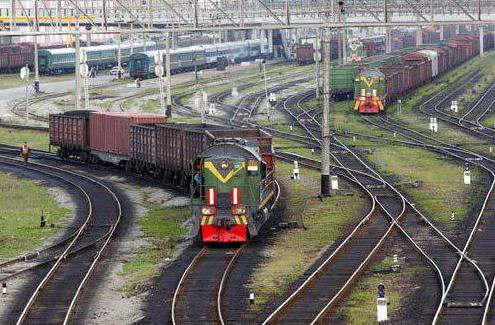
Winter
Railway transport and its uninterrupted operation in winter conditions need reliable protection from snow and timely cleaning of the turnout switch on each section of the track. Means and methods of dealing with the effects of snowstorms and snowfalls depend on the total intensity of precipitation. The best protection is forest belts along the entire length of difficult sections, which are planted parallel to the railway. Mobile shields, stationary reinforced concrete fences (especially in the city) are also used. Snowfall trains and cars SM-2M, SM-4M and so on up to model SM-7M are fighting snowfall at stations. Drivers rake the SDP-M2 snowplows, if the drifts are very large, then rotary and milling machines are used.
Turnouts have their own special mechanisms - these are stationary pneumatic devices for blowing. They have a remote control. Gas and electric heating devices are also used.
Sand
In areas of deserts and semi-deserts, protection of paths and turnouts from sand drifts is provided. The sections adjacent to the railway are fixed with vegetation, covered with bitumen, loam or a suspension with polymers. Another way out is to build defenses.
The first method is most effective. Best of all, trees fight against sand drifts - saxaul, goof, acacia, Circassian and others, but also shrubs - seluga, dzhuzgun, comb. Grass is also useful for this purpose, therefore, along the entire path through the desert, sandy oats, selin, elakilad, chager and other herbs that can survive in this climate are grown. Artificial protection is ineffective and is mainly used as a temporary measure.
Possible malfunctions
The use of switches is prohibited in the following malfunctions:
- If the switch points are disconnected from the rods.
- If the wit is behind the frame rail by more than four millimeters.
- If the wit is crumbled to the degree of danger of the crest.
- If the wit decreased by two millimeters or more relative to the frame rail.
- If there is a break in the frame rail or wit.
- If the frame rails and wits got vertical wear.
The failure of the second point is dangerous in the anti-wool direction, the fourth point - in the woolly direction, the rest - in any movement.
If the crosspiece of the turnout switch without a movable core, it is also characterized by other malfunctions in which the operation of the mechanism is prohibited:
- If there is a break in the counter rail, guardrail or core.
- If the core or guardrail has reached vertical wear.
- If the distance between the faces of the core of the cross and the head of the counter rail is less than 1472 millimeters.
- If the distance between the edges of the guardrail and the counter-rail head is more than 1435 millimeters.
- If the counter rail bolt is broken.
Failures of the first and second points are threatened by a descent, the third and fifth - the counter rail will not hold the wheelset, and the fourth - the wheel will be sandwiched between the guardrail and the counter rail.

Gear mechanism
Transfer mechanisms included in the centralization of automatic or manual operation of the devices, the arrows are transferred to another position. Widely used electric centralization. Manual control - in the mechanism, which is a simple lever device with a counterweight-balancer. The transfer mechanism is installed in a vertical position corresponding to the average position of the wits inside the space between the frame rails.
The wits are transferred to another position by means of special transfer devices, which are often included in electrical centralization, but there is also manual control. Electric drives can be of various designs - both mortise and non-mortise. LNG and SP drives are used, which have an inseparable stroke, two control rulers and one gate, through which the control contacts are closed, while the rulers control the wits, as they move together with them. If the wit does not reach the frame rail, the knife lever is not transferred.








